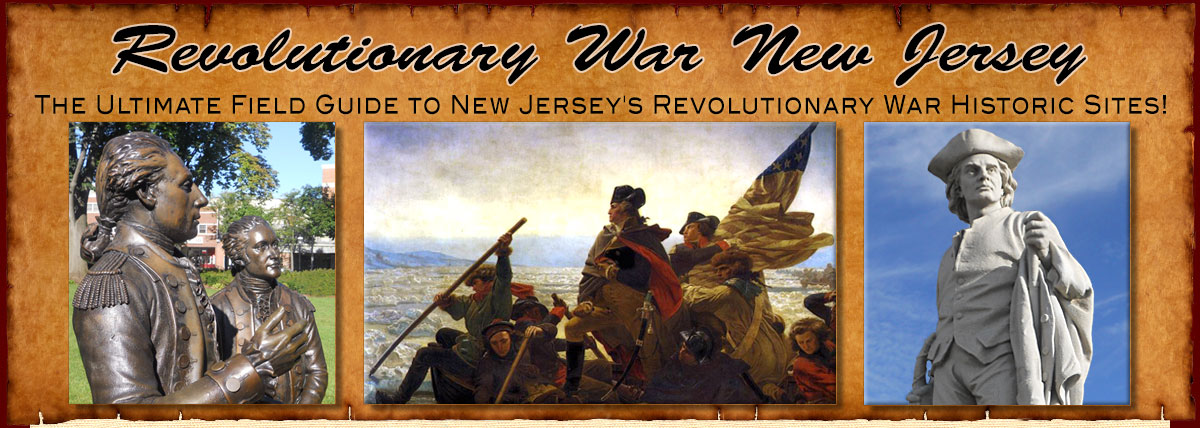

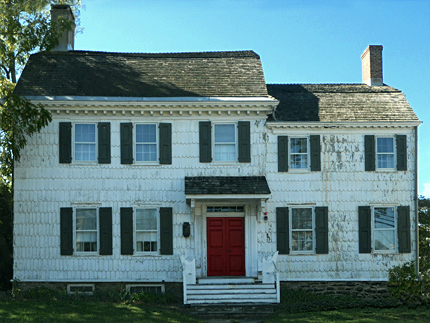
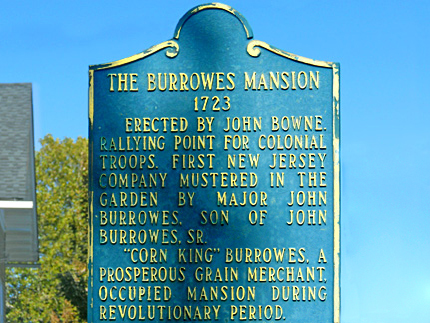
The Burrowes Mansion
94 Main St.
Map / Directions to Burrowes Mansion
Map / Directions to all Matawan Revolutionary War Sites
For more information about Burrowes Mansion, including visiting hours for tours, see the Burrowes Mansion Website.
Burrowes Mansion
Home of "Corn King" John Burrowes, Sr., and his son Major John Burrowes, Jr., during the Revolutionary War[1]
John Burrowes, Sr. was known as the "Corn King" because he was a wealthy and successful grain merchant who dealt mainly in corn. He was a strong and active supporter of the cause of American Independence, and had been for years before the Revolutionary War. In 1765 and 1766, a decade before the war began, John Burrowes, Sr. was a member of the Sons of Liberty, a group who protested the Stamp Act and defended the rights of the colonies. He was active in the sending of food and money in the support of Boston after the Boston Tea Party in 1773. In 1774, he served on a committee that chose the delegates who would represent New Jersey in the Continental Congress. [2]
His son, John Burrowes, Jr., was an officer in the Continental Army in the Revolutionary War, first as a Captain and then as a Major. [3] He trained a company of troops on the Burrowes's property.
John Burrowes, Sr., captured at Burrowes Mansion in a Loyalist Raid on May 27, 1778
Loyalists were Americans who remained loyal to the British in the Revolutionary War. Violence between Loyalists and those who supported Independence happened throughout many parts of New Jersey, but Monmouth County was a particular hotspot for this type of fighting. Raiding parties of Loyalists (also called Tories) attacked Monmouth County many times. [4]
One such raid was made on Matawan (then called Middletown Point) on May 27, 1778. The raiders had been informed that John Jr. was at home on furlough from the army, and they made an attempt to capture him. John Jr. escaped, but John Sr. was taken prisoner and held for several months.
A newspaper account in The New Jersey Gazette several days after the raid described the event: [5]
"[The Loyalists] marched to Mr. John Burrow[e]'s, made him prisoner, burnt his mills and both his store-houses, all valuable buildings, beside a great deal of his furniture — Also took Lieut. Col. John Smock, Capt. Christopher Little, Mr Joseph Wall, Capt. Jacob Covenhoven, and several other persons; killed — Pearce and — Van Prockle, and wounded another man mortally. Having completed these and several other barbarities, they precipitately returned the same morning to give an account of their abominable deeds to their bloody employers. A number of those gentry, we learn, were formerly inhabitants of that neighbourhood."

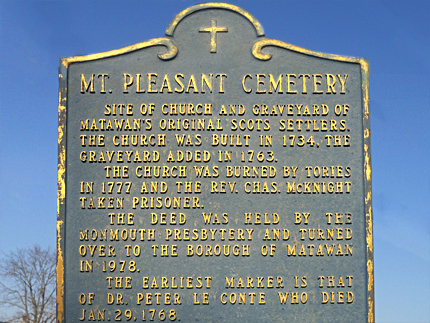
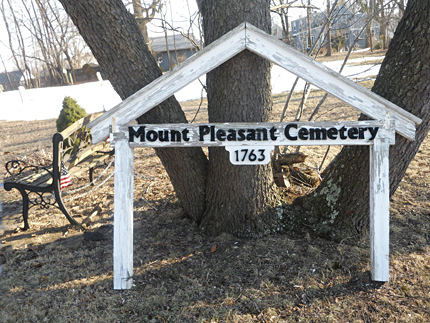
Mount Pleasant Cemetery / Site of Mount Pleasant Church
New Brunswick Ave near Main St.
Map / Directions to the Mt. Pleasant Cemetery
Map / Directions to all Matawan Revolutionary War Sites
Site of Mount Pleasant Church
This is the site of the Mount Pleasant Church, which was located here at the beginning of the Revolutionary War. The church's pastor was Reverend Charles McKnight, who was strongly and vocally pro-Independence. On April 13, 1777, the church was burned down by a raiding party of Tories, and McKnight was captured.
In his 1932 book, This Old Monmouth of Ours, William S. Hornor wrote the following account of the burning: [6]
"The Presbyterian church near Mount Pleasant and the green surrounding it had long been a focus for patriotic mass-meetings and a rallying-point for patriotic activities, these being ardently supported and participated in by the militant pastor, Reverend Charles McKnight. Now, the Tories, rancorous and revengeful, laid a plan to burn the meeting-house and carry its pastor to the captivity of a pestilential prison-house...
"The raid was completely successful, although few of its details have been handed down to us. There was considerable sharp fighting, men on both sides were killed and wounded, and the Reverend Mr. McKnight was carried off, to languish in [a] leprous British dungeon in New York—from the results of which he died in the following year."
Reverend Charles McKnight had a son name Charles Jr., who served as a surgeon in the Continental (American) Army during the Revolutionary War. [7]
The congregation of the Mount Pleasant Church has continued through the years at various church structures in different locations in Matawan. It is now the First Presbyterian Church of Matawan, located a half-mile north of here at 883 State Highway 34 in a church building which was built in the 1950's. [8]
The Cemetery [9]
Mount Pleasant Cemetery contains the graves of at least two Revolutionary War veterans: Mathias Hulsart (1756 - April 11, 1846) who served in the Monmouth County militia, and Major Thomas Hunn (October 8,1735 - September 15, 1796) who is described in more detail in the Hawkins House entry below.
The cemetery also contains the grave of Eleanor Freneau (1763 - September 1, 1850). Eleanor was the wife of Philip Freneau, who was known as the "Poet of the Revolution." Philip and Eleanor lived in Matawan, and more information can be found in the Philip Freneau House entry lower on this page.

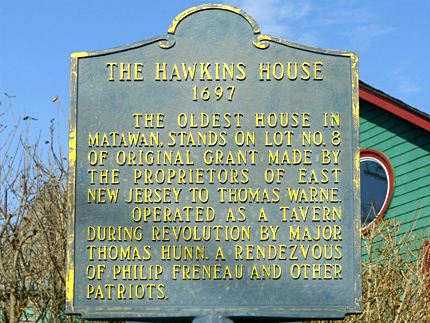
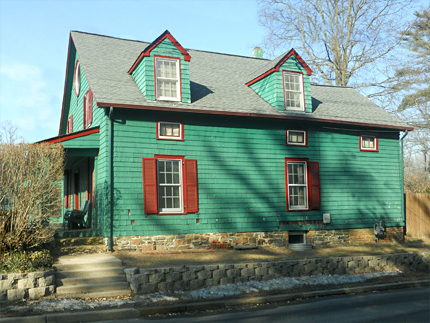
Hawkins House
Mill Rd. (Between Freneau Ave. and Saphire Ln.)
Map / Directions to the Hawkins House
Map / Directions to all Matawan Revolutionary War Sites
Major Thomas Hunn served in the First Regiment of the Monmouth County Militia. [10] He was in command of the Monmouth County militiamen who responded to the May 27, 1778 raid on this area, when John Burrowes was taken prisoner. (See the Burrowes Mansion entry above).
Two years later, Major Hunn was court-martialed. He was charged with cowardice, for which he was acquitted, and for "unofficer like behavior," for which he was found guilty. [11]
Major Thomas Hunn operated a tavern in this house during the Revolutionary War. According to the marker in front, the tavern was "a rendezvous of Philip Freneau and other patriots." [12] Philip Freneau was a local resident who was known as the "Poet of the Revolution." He is described in more detail in the following entry.

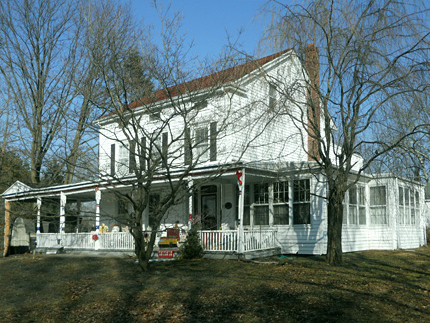
Philip Freneau House
12 Poet Dr.
Map / Directions to the Philip Freneau House
Map / Directions to all Matawan Revolutionary War Sites
Philip Freneau
Philip Freneau was born January 2, 1752 in New York City. His family moved to this property when he was a child. Freneau attended Princeton University, where he became friends with his classmate James Madison. Both men graduated in 1771.
During the Revolutionary War, Freneau wrote pro-American and anti-British poetry, for which he became known as the "Poet of the Revolution." He was captured by the British in 1778 and spent six weeks as a prisoner in one of their prison ships, which were known for their brutal conditions.
During the 1790's, Freneau became involved in the ongoing rivalry between Alexander Hamilton and Thomas Jefferson, both of whom were then serving in the cabinet of President George Washington. Freneau was made editor of the pro-Jefferson newspaper, the National Gazette from 1791-1793. [13]
In 1795, Freneau began publishing the Jersey Chronicle, which was the first newspaper published in Monmouth County. It was printed in a printshop that Freneau operated on this property.
The House and Property [14]
Philip Freneau lived in this house from 1818 until 1824. Prior to that, he had lived at a house on the same property which his father Pierre had built in 1752. Philip grew up in the old house, and he lived in it at various times throughout his adult life. He also began operating a print shop on the property in the 1790's.
Philip began building an additional house on the property in 1818. The old house burned down on October 18, 1818, and Philip moved into the new house, which was still in the process of being completed. It still stands here today and is pictured above.
Philip inserted a note about the loss of the old house in the Freneau family Bible:
"The old House at Mount Pleasant accidentally took fire on Sunday afternoon at 4 o'clock, October 18th—1818, precisely one year after my mother's decease. It was soon consumed to the ground with a large part of property therein. The following day we began to remove into the New House, which was partly finished. — said Old House was built in 1752 by my father — 42 feet in length and 24 in breadth."
Philip Freneau lived here with his wife Eleanor until 1824, when the couple then relocated to Freehold. Philip died in 1832 and was buried across the street from this house. (See Philip Morin Freneau Burial Site entry below). Philip's wife Eleanor, who died in 1850, is buried in the Mount Pleasant cemetery. (See Mt. Pleasant Cemetery entry above on this page.)
The Philip Freneau house is now a private residence.
Please respect the privacy and property of the owners.
The current owner of the house maintains the website www.philipfreneau.com,
which contains information about the house's history, as well as photos of the interior.

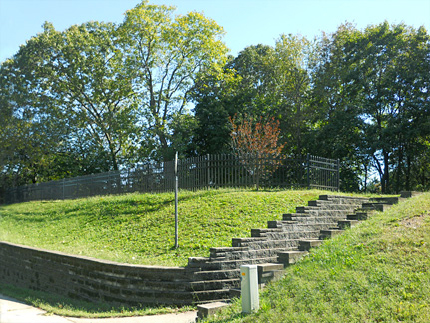
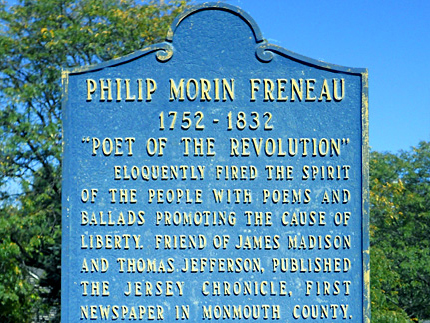
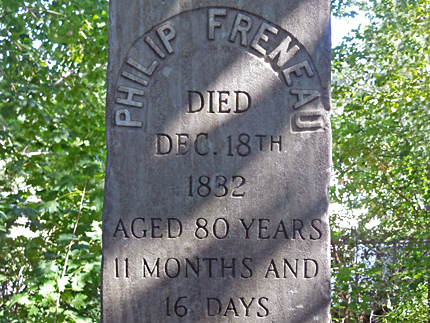
Philip Morin Freneau Burial Site
Poet Dr.
Map / Directions to the Freneau Gravesite
Map / Directions to all Matawan Revolutionary War Sites
Across from the Philip Freneau house on Poet Dr., you will find a set of stairs that leads up to a small cemetery which contains only the grave of Philip Freneau and his mother Agnes.
Freneau's grave is marked with an obelisk, which also marks his mother's grave. The obelisk is inscribed with this tribute:
"Philip Freneau. Died Dec. 18th, 1832 - Aged 80 years, 11 months, and 16 days. He was a native of New York, but for many years a resident of Philadelphia and New Jersey. His upright and benevolent character is in the memory of many and will remain when this inscription is no longer legible." [15]

1. ^ In addition to the sources listed in Source Note 2-4, general information about the Burrowes house and biographical details about John Sr. and Jr. in this entry were drawn from:
Helen Henderson, Matawan Historical Association, Matawan and Aberdeen: of Town and Field (Charleston SC: Arcadia Publishing, 2003) Pages 38-42
Available to be read at Google Books here
2. ^ Burrowes appointment to the committee which chose the New Jersey delegates to the Continental Congress is recorded in:
Minutes of the Provincial Congress and the Council of Safety of the State of New Jersey (Trenton: Naar, Day & Naar, 1879) Page 23
Available to be read at the Internet Archive here
3. ^ For more information on the military details about John Burrowes, Jr., see:
• William S. Stryker, Official Register of the Officers and Men of New Jersey in the Revolutionary War (Trenton: Wm. T. Nicholson & Co., 1872) Pages 56, 57, and 67
Available to be read at Google Books hereMinutes of the Provincial Congress and the Council of Safety of the State of New Jersey (Trenton: Naar, Day & Naar, 1879) Page 463
Available to be read at the Internet Archive here4. ^ Those who would like to read more about Loyalists in Monmouth County during the Revolutionary War are recommended to:
Michael Adelberg, The American Revolution in Monmouth County: The Theatre of Spoil and Destruction (Charleston, SC; The History Press) Pages 88-895. ^ "We are informed that on Wednesday morning last... ," New Jersey Gazette, Volume 1, No. 27, June 3, 1778, reprinted in:
Francis B. Lee, editor, Archives of the State of New Jersey, Second Series, Vol II (Documents Relating to the Revolutionary History of the State of New Jersey | Extracts from American Newspapers relating to New Jersey) (Trenton: John L. Murphy Publishing Company, 1903) Page 237
Available to be read at the Internet Archive here6. ^ William S. Hornor, This Old Monmouth of Ours (Originally published by Moreau Brothers of Freehold, New Jersey, 1932 / Reprinted for Clearfield Company, Inc. by Genealogical Publishing Co., Inc. Baltimore, Maryland 1990, 1999) Page 393
Available to be read at Google Books here
7. ^ Richard Harrison, et al., Princetonians - A Biographical Dictionary, Volume 2 (Princeton: Princeton University Press, 1976) Pages 156-159
~ Charles McKnight, Jr. is mentioned in several of General George Washington's letters and orders during the Revolutionary War, including the following which are available to be read at the Founders Online / National Archives website:
• “From George Washington to Major General William Heath, 18 September 1776,” Founders Online, National Archives, last modified July 12, 2016, http://founders.archives.gov/documents/Washington/03-06-02-0266. [Original source: The Papers of George Washington, Revolutionary War Series, vol. 6, 13 August 1776 – 20 October 1776, ed. Philander D. Chase and Frank E. Grizzard, Jr. Charlottesville: University Press of Virginia, 1994, pp. 338–339.]
• “General Orders, 9 December 1777,” Founders Online, National Archives, last modified July 12, 2016, http://founders.archives.gov/documents/Washington/03-12-02-0528. [Original source: The Papers of George Washington, Revolutionary War Series, vol. 12, 26 October 1777 – 25 December 1777, ed. Frank E. Grizzard, Jr. and David R. Hoth. Charlottesville: University Press of Virginia, 2002, pp. 581–582.]
• “General Orders, 19 October 1780,” Founders Online, National Archives, https://founders.archives.gov/documents/Washington/03-28-02-0329. [Original source: The Papers of George Washington, Revolutionary War Series, vol. 28, 28 August–27 October 1780, ed. William M. Ferraro and Jeffrey L. Zvengrowski. Charlottesville: University of Virginia Press, 2020, pp. 600–601.]
•“From George Washington to Major General William Heath, 24 October 1780,” Founders Online, National Archives, https://founders.archives.gov/documents/Washington/03-28-02-0364. [Original source: The Papers of George Washington, Revolutionary War Series, vol. 28, 28 August–27 October 1780, ed. William M. Ferraro and Jeffrey L. Zvengrowski. Charlottesville: University of Virginia Press, 2020, pp. 639–640.]
• “George Washington to Major General William Heath, 12 April 1781,” Founders Online, National Archives, https://founders.archives.gov/documents/Washington/03-31-02-0247. [Original source: The Papers of George Washington, Revolutionary War Series, vol. 31, 7 March–5 May 1781, ed. William M. Ferraro. Charlottesville: University of Virginia Press, 2023, pp. 354–355.]
8. ^ History page of the First Presbyterian Church of Matawan website
9. ^ Information drawn from:
• Mathias Hulsart and Eleanor Freneau gravestones in the cemetery
• William S. Hornor, This Old Monmouth of Ours (Originally published by Moreau Brothers of Freehold, New Jersey, 1932 / Reprinted for Clearfield Company, Inc. by Genealogical Publishing Co., Inc. Baltimore, Maryland 1990, 1999) Pages 162-163
Available to be read at Google Books here
▸ Hornor states that Major Hunn "is buried in the old cemetery between Matawan and Freneau, by the side of his wife Catherine."
Based on this information, it appears that Major Hunn's grave is marked with a large white flat stone that is now unreadable. It can be located because it stands next to and near several other Hunn family stones which are readable.• The Daughters of the American Revolution Genealogical Research System
• William S. Stryker Official Register of the Officers and Men of New Jersey in the Revolutionary War (Trenton: Wm. T. Nicholson & Co., 1872) Pages 344 and 639.
Available to be read at Google Books here
10. ^ Information drawn from:
• William S. Stryker Official Register of the Officers and Men of New Jersey in the Revolutionary War (Trenton: Wm. T. Nicholson & Co., 1872) Page 344.
Available to be read at Google Books here• The Daughters of the American Revolution Genealogical Research System, where Thomas Hunn is Ancestor # A060064
11. ^ "By His Excellency the Governor," New Jersey Gazette, Vol IV, No 166, Feb 28, 1781, reprinted in:
Austin Scott, Ed., Archives of the State of New Jersey, Second Series, Vol. V. (Trenton; Star Gazette Publishing Co., 1917) Page 200
Available to be read at Google Books here12. ^ Historic sign in front of the Hawkins House.
13. ^ For details about Freneau's involvement with the Hamilton/Jefferson/National Gazette episode, see:
• Ron Chernow, Alexander Hamilton (New York: The Penguin Group, 2004) Pages 395-397, 400, 402-405, 407, 412, 424, 433, 445, 446, 453, 476, and 498
• Joseph J. Ellis, American Creation (New York: Alfred A. Knopf, 2007) Chapter Five: "The Conspiracy," Pages 165-206
14. ^ Information about the history of the house and property was drawn from the website www.philipfreneau.com, which is maintained by the current owner of the house. The website is recommended to those looking for more information about the history of the house.
The website includes several photos of original documents related to the history of the house, including the page from the Freneau family Bible where Philip inserted a note about the old house burning down, which is the source of the quoted text.
15. ^ Text of the Philip Freneau grave obelisk